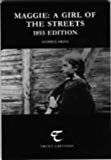
Maggie: A Girl of the Streets (1893 Edition) PDF
Preview Maggie: A Girl of the Streets (1893 Edition)
Maggie is plainly an important text, written at a time when the United States were in the midst of a series of economic and cultural crisis and the widespread sense of optimism in America after the Civil War was steadily being replaced by disillusion. Political and commercial corruption were rightly perceived to characterize business life as the nineteenth century drew to a close. The gradual shift in these decades from the stereotype of the thrifty, hard-working American to a vision of selfhood defined by consumption stemmed from a recognition that, in an increasingly urbanized society, traditional ideas about what Americans should aspire to were rapidly becoming anachronistic. In Maggie, Crane offers a particularly radical commentary on this America as manifest in the nineteenth century’s finale decade.
With its frank portrait of slum tenement life and prostitution, the book was in danger of offending the sensibilities of a reading public as yet acquainted with the vigorous naturalist fictions of Frank Norris, Jack London and Theodore Dreiser. As such, Maggie, a Girl of the Streets ranks in importance alongside Crane’s other masterpiece, The Red Badge of Courage.
(Edited, with an introduction and notes, by Christopher Gair. The first edition of this text was published in 1893 under the pseudonym Johnston Smith. Most reprints of the novel have followed the revised 1896 text, yet Crane made a number of cuts and changes for this later edition. Most significantly, he deleted much of a paragraph describing a menacing encounter Maggie has just before her death. Once this cut is restored, the implications of her death are substantially altered, a shift above all marked by a fundamental adjustment to the gender politics of the book.)
